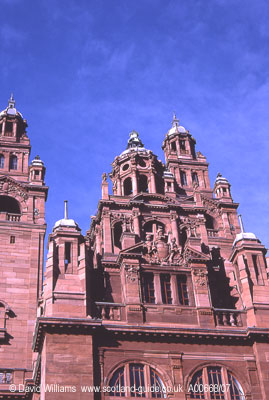The 1888 International Exhibition was the first of Glasgow`s exhibitions and it was staged for two main reasons: firstly, to show off the city`s great achievements and to emphasise its position as `The Second City`; and secondly, to raise finance for what is now Kelvingrove Art Gallery and Museum. The city`s art collection had outgrown the McLellan Galleries and a large prestigious home was now needed; Kelvingrove House was already housing some artefacts but a purpose-built building was sought.
The Glasgow architect James Sellars was responsible for choosing an oriental style for the exhibition`s buildings and the temporary structures sported flamboyant domes and minarets. The exhibition halls had collections of paintings, sculpture (2700 exhibits in total) and all manner of industrial equipment. There was also a reconstruction of the city`s Bishops` Castle and a Dutch Cocoa House. Outdoor exhibits included an electrically illuminated Fairy Fountain and the magnificent Doulton Fountain which is now in Glasgow Green. The exhibition lasted from May to November and nearly 6 million people visited it.
The Kelvingrove Art Gallery and Museum was completed by the time of the 1901 International Exhibition.
This article is based
on the guidebook "The
Glasgow Guide".

Kelvingrove Art Gallery and Museum was financed through the success of the 1888 International Exhibition.